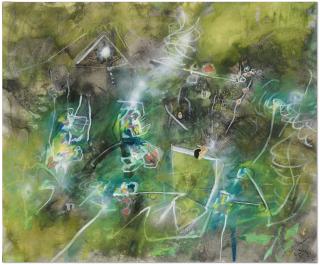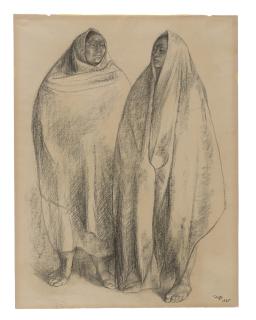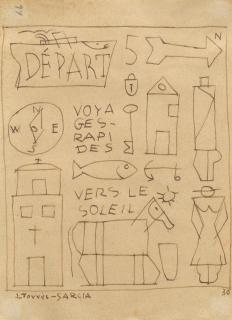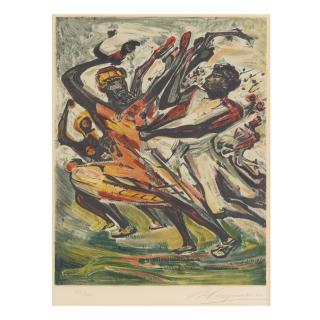Leonora Carrington 1917 - 2011
The artist Leonora Carrington
- Surrealist painter and writer.
- Great success in Paris until World War II, later a life away from the art center.
- In the second half of the 20th century she became famous in Mexico.
Leonora Carrington (1917-2011) was born in England and grew up in a wealthy, strict Catholic family. She was a rebellious child and was expelled from schools several times. With her mother's help, she managed to study painting in London from 1935, against her father's wishes. Two years later Carrington met the surrealist painter Max Ernst, whom she followed to Paris to live with him and become part of the surrealist circle of artists. Through this move, she broke finally with her father.
Carrington experienced among the Surrealists the sense of freedom she had been searching for. She and her work fascinated both her peers and the public. Two of her paintings were exhibited at the 1938 International Surrealist Exhibition in Paris. Dream and fantasy dominated Carrington's mystical paintings with their mythical creatures and beings. Within a very short time, Carrington was the sensation of the Surrealist movement, which was in its heyday in the late 1930s. The outbreak of World War II and the occupation of France abruptly ended Carrington's brief career in Paris. Max Ernst, considered a »degenerate« artist, was arrested by the Gestapo, escaped, and with Peggy Guggenheim's help, emigrated to the United States. Ernst and Guggenheim married. Carrington had been left behind by Ernst.
She moved to Madrid with a friend, where she suffered a breakdown. Through numerous contacts, Carrington's father had her declared terminally insane and committed to an asylum, where she was given shock therapy with various drugs. After four months, a cousin of Carrington's was able to obtain her release. At the British Embassy in Lisbon, Carrington married diplomat Renato Leduc, a friend of Picasso's, which gave her immunity and allowed her to flee Europe easily. After a year, they reached Mexico City, where they divorced as agreed. Here Carrington spent almost the rest of her life.
Carrington married Emerico Weisz, an émigré photographer, with whom she had two sons and lived until his death in 2007. She was very successful in Mexico as an artist and writer, and numerous sculptures are on public display. Mexican culture enriched her fantasy worlds and creations. Until her death in 2011, Carrington was also active as a women's rights activist. While she is remembered in Europe primarily as Max Ernst's companion, in Mexico she was celebrated as an artist. At the beginning of the 21st century, she was also rediscovered in the USA and Europe.
Die Künstlerin Leonora Carrington
- Surrealistische Malerin und Schriftstellerin.
- Großer Erfolg in Paris bis zum 2. Weltkrieg, später ein Leben abseits des Kunstzentrums.
- In der zweiten Hälfte des 20. Jahrhunderts wurde sie in Mexiko berühmt.
Leonora Carrington (1917-2011) wurde in England geboren und wuchs in einer wohlhabenden, streng katholischen Familie auf. Sie war ein rebellisches Kind und wurde mehrfach von Schulen verwiesen. Mit der Hilfe ihrer Mutter gelang es ihr, gegen den Willen des Vaters ab 1935 in London Malerei zu studieren. Zwei Jahre später lernte Carrington den surrealistischen Maler Max Ernst kennen, dem sie nach Paris folgte, um dort mit ihm zu leben und Teil des surrealistischen Künstlerkreises zu werden. Durch diesen Schritt brach sie endgültig mit ihrem Vater.
Carrington erlebte unter den Surrealisten das Freiheitsgefühl, nach dem sie gesucht hatte. Sie und ihre Arbeiten faszinierten sowohl ihre Mitstreitenden als auch das Publikum. Auf der Internationalen Surrealisten-Ausstellung 1938 in Paris wurden zwei ihrer Bilder ausgestellt. Traum und Fantasie beherrschten Carringtons mystische Gemälde mit ihren Fabelwesen und Kreaturen. Innerhalb kürzester Zeit war Carrington die Sensation der surrealistischen Bewegung, die sich Ende der 1930er-Jahre in ihrer Hochzeit befand. Der Ausbruch des Zweiten Weltkriegs und die Besetzung Frankreichs beendeten Carringtons kurze Karriere in Paris schlagartig. Max Ernst wurde als »entartet« geltender Künstler von der Gestapo verhaftet, konnte fliehen und wanderte mit Peggy Guggenheims Hilfe in die USA aus. Ernst und Guggenheim heirateten. Carrington war von Ernst zurückgelassen worden.
Sie zog mit einer Freundin nach Madrid, wo sie einen Zusammenbruch erlitt. Über zahlreiche Kontakte ließ Carringtons Vater sie für unheilbar geisteskrank erklären und in eine Heilanstalt einweisen, wo sie mit diversen Drogen Schock therapiert wurde. Nach vier Monaten konnte ein Cousin Carringtons die Entlassung erwirken. In der britischen Botschaft in Lissabon heiratete Carrington den Diplomaten Renato Leduc, einen Freund Picassos, wodurch sie Immunität erlangte und problemlos aus Europa fliehen konnte. Nach einem Jahr erreichten sie Mexiko-Stadt, wo sie sich wie vereinbart scheiden ließen. Hier verbrachte Carrington fast ihr gesamtes restliches Leben.
Carrington heiratete den emigrierten Fotografen Emerico Weisz, mit dem sie zwei Söhne bekam und bis zu dessen Tod 2007 zusammenlebte. In Mexiko war sie als Künstlerin und Autorin sehr erfolgreich, zahlreiche Skulpturen sind öffentlich ausgestellt. Die mexikanische Kultur bereicherte ihre Fantasiewelten und -gestalten. Bis zu ihrem Tod 2011 war Carrington außerdem als Frauenrechtlerin aktiv. Während sie in Europa vor allem als Lebensgefährtin Max Ernsts in Erinnerung geblieben ist, wurde sie in Mexiko als Künstlerin gefeiert. Anfang des 21. Jahrhunderts wurde sie auch in den USA und Europa wiederentdeckt.
Leonora Carrington in News and Exhibitions
The joy of artistic experimentation in person
Surrealist artist Leonora Carrington is currently one of the most talked about artists of the 20th century. From July 12, Newlands House Gallery in Petworth will be showing the breadth of her work in Leonora Carrington: Rebel Visionary.
Leonora Carrington in News and Exhibitions
Die künstlerische Experimentierfreude in Person
Die surrealistische Künstlerin Leonora Carrington ist derzeit eine der meistbesprochenen Künstlerinnen des 20. Jahrhunderts. Die Newlands House Gallery in Petworth zeigt in Leonora Carrington: Rebel Visionary ab dem 12. Juli die Bandbreite ihres Schaffens.

















































